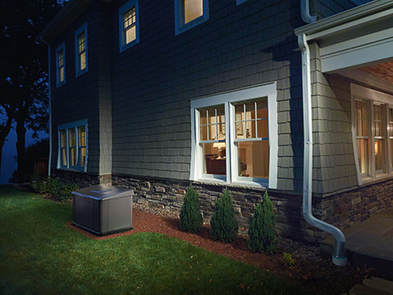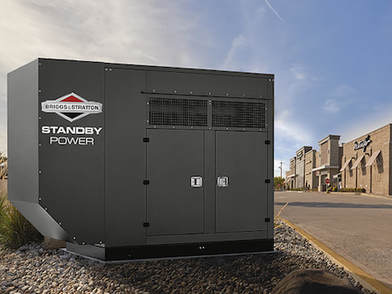GENERATOR BASICS
Click the links below to learn more about back up standby generator installation requirements, procedures, and processes. Learn how it all works and the specific steps we take, in order to provide you and your family with back up power in times of need.
HOW DO GENERATORS WORK?
A home or residential standby generator system consists of two components: a standby generator unit and an automatic transfer switch. The two work in conjunction with your home to ensure that power is never lost, and it only takes seconds before the backup power generator kicks in.
A standby generator system and automatic transfer switch are professionally installed to your home’s existing wiring. This means your new backup generator works seamlessly with your home, to ensure protection.
The system is on constant standby and immediately senses when utility power stops flowing to your home, thus confirming a power outage. Within moments, the automatic transfer switch transfers your home’s electrical circuits and appliances to backup standby power. Once the generator system senses utility power is back up and running, your home will be automatically transferred back to utility power and the standby generator is shut down until it’s needed again.
CHOOSE BETWEEN NATURAL GAS & LIQUID PROPANE GENERATORS
Standby generator systems operate on either natural gas or liquid propane. Both natural gas and propane generators provide a seamless transition from utility to backup power. If your home is already equipped with one fuel or the other, it makes sense to use what’s already available.
WHY GET A STANDBY GENERATOR?
With the seemingly ever-growing frequency of major storms in recent years, the need for backup standby generators are becoming more and more evident. When your home is glowing with lights when the surrounding areas are dark, and when your home is cool when it’s hot (and warm when it’s not), that’s when backup power really proves its worth.
Standby generators not only protect you and your family during these trying times, but can power your home for days, in the event of an outage and until power is restored.
HOW TO HAVE A GENERATOR INSTALLED
Once you select the standby power generator that’s right for you, East Texas Generator handles all the details. You choose a standby power generator to make your life easier. We make getting your system even easier.
East Texas Generator’s 9-Step process:
- Site evaluation
We gather all critical information to determine your power requirements, load calculation, location of where your new back up power generator is to sit, size of generator needed, along with appropriate transfer switch. - Quote process and diagram
A complete and thorough explanation of the equipment required for the power needs of the buyer is provided. Spec sheets are sent along with quote containing all the information about what will be furnished and installed. - Permitting (if necessary) and CenterPoint Approval
If the installation is in an area that requires permitting, we will apply for and obtain any permits, prior to any work performed. Every installation requires a one-line diagram be submitted for approval to you energy provider, showing the installation diagram, as well as the specifications of the generator and the automatic transfer switch. - HOA approval (if necessary)
If you reside in a Home Owner’s Associations and they require approval prior to installing a standby generator, we’ll work with them to get the proper permissions. - Concrete pad
We locate and professionally pour a concrete pad for your new back up standby generator to call home. - Electrical systems install and inspection
Incorrect electrical installation can result in damage to the equipment, not covered under manufacturer or installation warranty. There is a right way and wrong way to wire a standby generator system with a transfer switch. Passing inspection doesn’t always mean it is installed correctly. We ensure that your system is correctly installed, no questions asked. - Plumbing installation & inspection
As with installation, there is a right and wrong way to plumb a standby generator. Even if a job passes inspection, that doesn’t necessarily mean it is plumbed correctly for a standby generator. Experience is the best guide to be certain of proper installation. - Gas provider services setup
Standby generators fueled by natural gas or propane run best with elevated pressure. This sometimes requires an upgraded meter from the natural gas provider. - Startup and walkthrough
After completion of the installation process, one of our trained technicians will set an appointment to start up the generator and leads you through a detailed tutorial covering operation of your new system.
WHAT SIZE GENERATOR DO I NEED?
Choosing the right standby generator installation is not as cut and dry as one might thing. You must consider all the appliances and electrical items that your household may need to run and operate during an outage. Don’t forget, an outage could last several days, make sure you get a back up generator that will suit your family’s needs.
Click the button above to access the Briggs & Stratton home or business standby generator selection tool to see which model with give you the power you need.
GENERATOR INSTALLATION ESTIMATES



